About
Special News
Logan's Page
Jacoby's Page
Our Travel Index
Tracks Ahead Related Trips
Contact
Golden Eagle Trans-Siberian Express - 2011
Vladivostok - Moscow
|
|
We cross nearly the length of Russia, from East to West, aboard a luxury railroad train; the Golden Eagle Express! Along the way we visit Siberia,and Mongolia. |
Sept 2-4
The shuttle van driver
showed up a little late on Friday night, but it was not a problem.
After our pick-up at 6:45 PM, we
headed to pick up John and
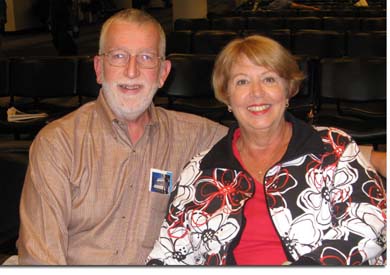 Kent.
From that point, it was a straight
shot to Chicago O’Hare, and our Korean Air flight to Seoul, which will
be our transfer point to Vladivostok.
The plane was not full, so the guys
were able to catch some sleep on the 14 and a half hour journey.
Barb and I had seats that flattened
out, thus insuring about 6 hours of sleep.
So here we are in the Prestige Korean
Air lounge, killing five hours. Our next stop is in Russia.
Kent.
From that point, it was a straight
shot to Chicago O’Hare, and our Korean Air flight to Seoul, which will
be our transfer point to Vladivostok.
The plane was not full, so the guys
were able to catch some sleep on the 14 and a half hour journey.
Barb and I had seats that flattened
out, thus insuring about 6 hours of sleep.
So here we are in the Prestige Korean
Air lounge, killing five hours. Our next stop is in Russia.
Yes.
Here we are in Vladivostok.
How many people can say that?
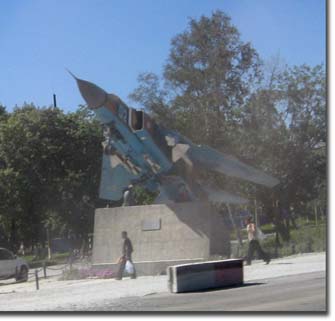 Taking
a cue from the West, the airport has a mounted airplane on a pedestal.
But this one is a Mig-25.
We had to use stairs to exit the
plane, and boarded a bus.
The subsequent bus tide to the
terminal was – about 25 feet.
Somebody, somewhere, said, “The bus
will be used to transport passengers.”
A holdover to the inefficiencies of
socialism?
Giving someone a job?
I don’t know.
Taking
a cue from the West, the airport has a mounted airplane on a pedestal.
But this one is a Mig-25.
We had to use stairs to exit the
plane, and boarded a bus.
The subsequent bus tide to the
terminal was – about 25 feet.
Somebody, somewhere, said, “The bus
will be used to transport passengers.”
A holdover to the inefficiencies of
socialism?
Giving someone a job?
I don’t know.
The city was a closed
area until 1991, because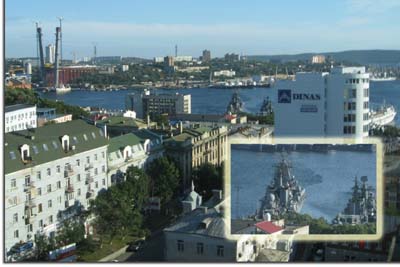 it was the home of the Russian Pacific fleet.
Even Russian citizens needed special
permission to visit here.
As a result, the city was built at a
time when owning an automobile was a luxury.
Now, however, there are plenty of
cars.
And there is a major effort underway
to upgrade the road infrastructure.
Which resulted in a long, slow, bumpy
and dusty ride from the airport.
Some of the dwellings look pretty
humble along the road.
We are ensconced at the Hotel Hyundai,
with views over the harbor.
And there are a couple of minor naval
vessels moored here.
I don’t know if they are museum pieces
or not, but it is my understanding that the Pacific fleet is moored
elsewhere.
So Vladivostok (means Rule the East)
is positioning itself for tourists and conventions.
It
it was the home of the Russian Pacific fleet.
Even Russian citizens needed special
permission to visit here.
As a result, the city was built at a
time when owning an automobile was a luxury.
Now, however, there are plenty of
cars.
And there is a major effort underway
to upgrade the road infrastructure.
Which resulted in a long, slow, bumpy
and dusty ride from the airport.
Some of the dwellings look pretty
humble along the road.
We are ensconced at the Hotel Hyundai,
with views over the harbor.
And there are a couple of minor naval
vessels moored here.
I don’t know if they are museum pieces
or not, but it is my understanding that the Pacific fleet is moored
elsewhere.
So Vladivostok (means Rule the East)
is positioning itself for tourists and conventions.
It
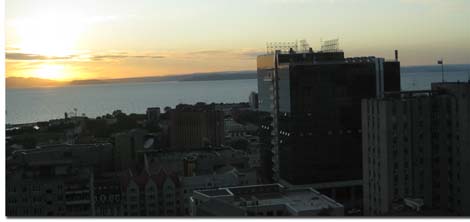 is,
after all, the only large Russian city on the east coast.
is,
after all, the only large Russian city on the east coast.
Interestingly, most of
the cars are right hand drive, having been brought over used from Japan.
Dinner was at the top of the hotel,
overlooking Golden Horn Bay.
Sept 5
Dawn does not come quite as early here as it does back home. Nevertheless, we were up and met our guide, Olga, and driver Sergei around 9:30. We were totally uncertain of the weather today, due to a typhoon hovering off the coast of Japan. So it was windy, and somewhat overcast until mid-morning. We had intended to take a ferry ride to Ruska Island, to get some waterfront overviews, but due to the winds, that trip was cancelled.
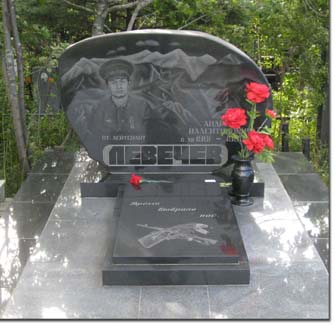 So we headed to the Russian Naval Cemetery.
Arlington it was not, as it was overgrown and rather poorly
tended.
The headstones were
interesting, in that people’s photos were lithographed, and attached to
the grave marker.
Some of
these folks looked pretty severe.
So we headed to the Russian Naval Cemetery.
Arlington it was not, as it was overgrown and rather poorly
tended.
The headstones were
interesting, in that people’s photos were lithographed, and attached to
the grave marker.
Some of
these folks looked pretty severe.
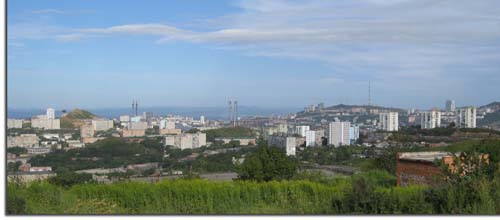
We
were able to get a few overview shots of the city, which has the
military presence of San Diego, but the terrain of San Francisco.
There were also a few Mig-29s flying around.
It felt kind of strange to
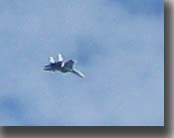 be seeing these things, instead of the
US F-16 that we see almost every day in Arizona.
be seeing these things, instead of the
US F-16 that we see almost every day in Arizona.
Then it was off to the waterfront, with a deserted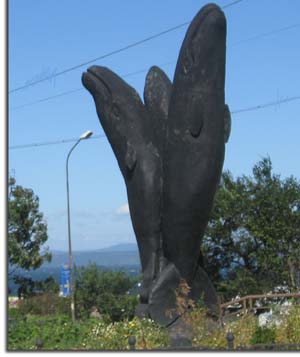 children’s
playground.
The wind was
whipping up big whitecaps on Golden Horn Bay.
Then the Three Whales statue, which was a testament to the rescue
of three whales off the coast of Alaska several years prior.
A department store for a new plug strip was the next stop, and
then lunch in a cosmopolitan restaurant.
children’s
playground.
The wind was
whipping up big whitecaps on Golden Horn Bay.
Then the Three Whales statue, which was a testament to the rescue
of three whales off the coast of Alaska several years prior.
A department store for a new plug strip was the next stop, and
then lunch in a cosmopolitan restaurant.
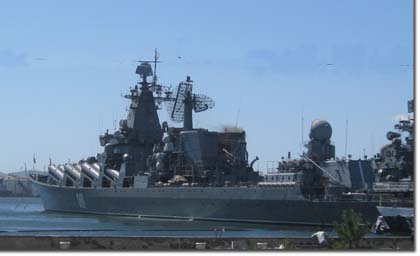 Off to the naval display with the C-56 Pacific Fleet submarine
from WW2.
The memorial
dedicated to those that lost their lives in WW2 featured some great
examples of Soviet monolithic realism, as well as a wall of bronze
plaques that appeared to open like a book as you moved along it.
There was a chapel, dedicated to St. Andrew, the patron saint of
Off to the naval display with the C-56 Pacific Fleet submarine
from WW2.
The memorial
dedicated to those that lost their lives in WW2 featured some great
examples of Soviet monolithic realism, as well as a wall of bronze
plaques that appeared to open like a book as you moved along it.
There was a chapel, dedicated to St. Andrew, the patron saint of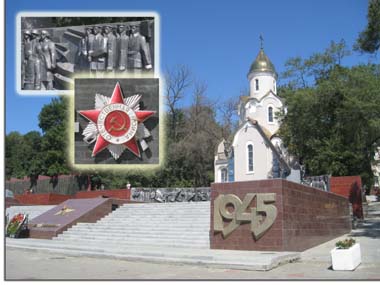 seamen.
Behind the memorial,
was a portion of a noble’s palace that had been restored?
I have no idea who or what it was.
Some shots of the warships at anchor completed the day.
The city never had much beyond the naval fleet, and was closed to
the general public.
So cargo
facilities were never constructed, and shipping and freight traffic
moved to another city further up the coast.
Now, the city is
seamen.
Behind the memorial,
was a portion of a noble’s palace that had been restored?
I have no idea who or what it was.
Some shots of the warships at anchor completed the day.
The city never had much beyond the naval fleet, and was closed to
the general public.
So cargo
facilities were never constructed, and shipping and freight traffic
moved to another city further up the coast.
Now, the city is
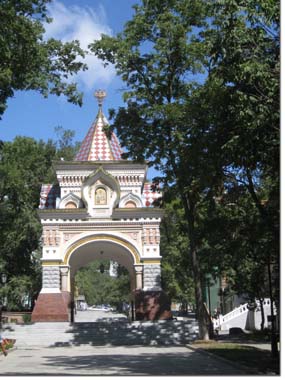 trying to capture the convention business, and
restoring and rebuilding, which includes the roads and the central
heating system.
A note on
that.
All Russian cities are
centrally heated.
So each
year the system must be repaired, which means no hot water for sometimes
up to a month.
Olga said
that the Russians are optimistic that better times are ahead.
We talked to Tatiana and decided to wait to interview her on the
train.
So basically we all
took naps, had dinner at the hotel, and turned in.
The jet lag is still a bit much.
trying to capture the convention business, and
restoring and rebuilding, which includes the roads and the central
heating system.
A note on
that.
All Russian cities are
centrally heated.
So each
year the system must be repaired, which means no hot water for sometimes
up to a month.
Olga said
that the Russians are optimistic that better times are ahead.
We talked to Tatiana and decided to wait to interview her on the
train.
So basically we all
took naps, had dinner at the hotel, and turned in.
The jet lag is still a bit much.
Sept 6
The typhoon blew in overnight.
The wind howled around our windows,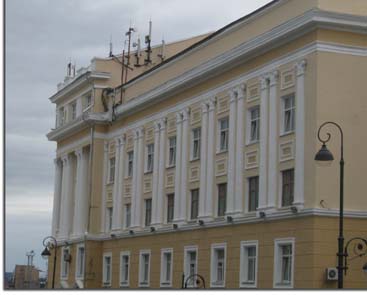 and it was raining well into
the morning.
While the
temperature started out low, it and the humidity ramped up over the
morning hours.
Undaunted, we
started off to walk part of the downtown.
There was the usual construction, and it is easy to see why
everyone has such great legs – it is just like walking in San Francisco.
Still, how women manage to survive without broken ankles on these
treacherous streets in their killer heels is a mystery.
Obviously, it takes a lot of practice.
and it was raining well into
the morning.
While the
temperature started out low, it and the humidity ramped up over the
morning hours.
Undaunted, we
started off to walk part of the downtown.
There was the usual construction, and it is easy to see why
everyone has such great legs – it is just like walking in San Francisco.
Still, how women manage to survive without broken ankles on these
treacherous streets in their killer heels is a mystery.
Obviously, it takes a lot of practice.
A block or so from the hotel we shot some of the early 20th
century architecture, as well as another city skyline on this grey day.
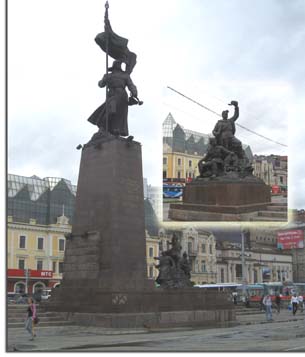 We walked down to an open area, with three statues as a monument
to Russia Conquering the Far East.
To get there, rather than cross the street, there were
underground walkways.
We walked down to an open area, with three statues as a monument
to Russia Conquering the Far East.
To get there, rather than cross the street, there were
underground walkways.
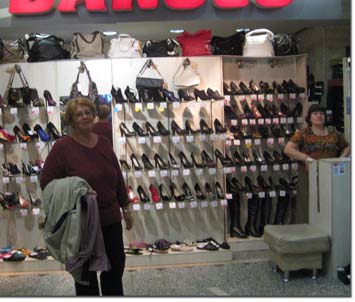 This
subterranean area turned out to be lined with shops most of which sold
shoes. So many shoe shops, so
little time!
Barb had to check things out.
This
subterranean area turned out to be lined with shops most of which sold
shoes. So many shoe shops, so
little time!
Barb had to check things out.
We saw a
pedestrian bridge that turned out to be the ramp to the train station.
So we found several commuter trains, which all looked sort of
1950ish modern, with wooden seats.
Yikes.
The Russians seem to have lost any Western design sense when they built
these things. It was a theme we would see repeated - brutish and
powerful.
several commuter trains, which all looked sort of
1950ish modern, with wooden seats.
Yikes.
The Russians seem to have lost any Western design sense when they built
these things. It was a theme we would see repeated - brutish and
powerful.
There was also
a display of an Alco 2-10-0 which was part of the lend lease program.
Initially we got chased off by some police, (who I think wanted a
hand out) but we wandered off, waited for them to leave, and went back
and shot the engine anyway.
We also shot a bit of the exterior of the Victorian style main railway
station.
It is from here
that our train will depart tomorrow.
So it was a good day, and we seem to have acquired all we need so
far of Vladivostok.
My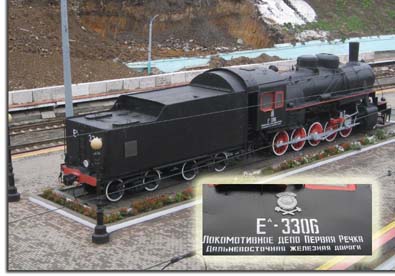 impressions of the place raise the question of why anyone would want to
come here.
impressions of the place raise the question of why anyone would want to
come here.
As someone said, “It is because it’s there.” Just like climbing a mountain. There is tons of construction, with highways and streets torn up all over the place. A new cable stayed bridge over the strait is under construction. Buildings are being gussied up. All of this is due to a major conference which is to be held here in 2012.
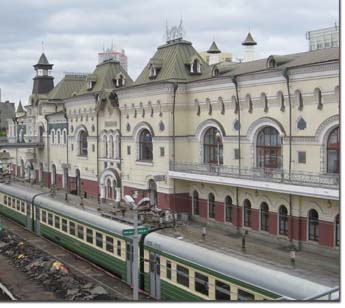 The people wonder
if it will all get done, and if the rapid pace of the construction will
lead to shoddy workmanship.
All remains to be seen.
The
citizens are typically Russian – tall, with fair complexions.
And is typical is Russia, no one smiles.
The total population is around 700,000, and the city is now open
to everyone.
Before 1991 you
needed a special pass to get in the place.
Tonight we start the tour, with a welcome dinner.
It will be just us and 90 of our new friends.
The people wonder
if it will all get done, and if the rapid pace of the construction will
lead to shoddy workmanship.
All remains to be seen.
The
citizens are typically Russian – tall, with fair complexions.
And is typical is Russia, no one smiles.
The total population is around 700,000, and the city is now open
to everyone.
Before 1991 you
needed a special pass to get in the place.
Tonight we start the tour, with a welcome dinner.
It will be just us and 90 of our new friends.
We checked out of the
hotel this morning, as the tour officially started.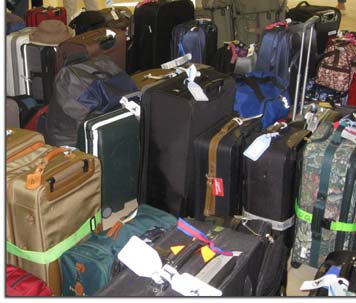 There were mountains of luggage. How will it all fit on the train?
We are off to the Arseniev Museum,
which turned out to be a natural history museum. So there are
plenty of tigers, indigenous animals, all of which are pretty well
preserved. My brother was impr
There were mountains of luggage. How will it all fit on the train?
We are off to the Arseniev Museum,
which turned out to be a natural history museum. So there are
plenty of tigers, indigenous animals, all of which are pretty well
preserved. My brother was impr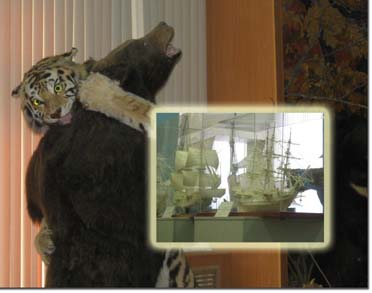 essed
by the quality of the place. Additionally, there was a history of
this, the Primorskye region.
essed
by the quality of the place. Additionally, there was a history of
this, the Primorskye region.
Upon exiting, we were treated to a bit of
maintenance work in the street. Somehow, using an aluminum ladder
to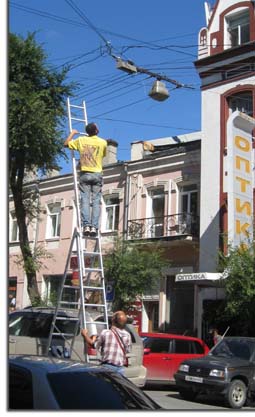 work on the overhead electrical lines seems a tad dangerous.
Obviously, OSHA has not had any influence in this region.
work on the overhead electrical lines seems a tad dangerous.
Obviously, OSHA has not had any influence in this region.
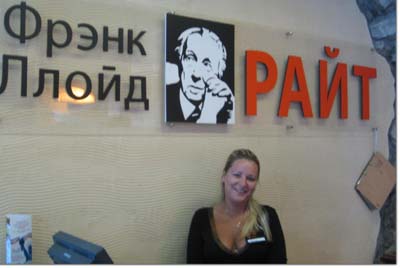 Lunch was - of all things at a Frank Lloyd Wright inspired restaurant.
Who would have thought to find such a place here? So starts our
introduction to Russian cuisine.
Lunch was - of all things at a Frank Lloyd Wright inspired restaurant.
Who would have thought to find such a place here? So starts our
introduction to Russian cuisine.
On the tour again, we ended up back at the submarine
exhibit again.
 This
time we had more time to tour the interior of this WW2 fleet class sub.
From there, it was off to the Arsenal Fortress museum. This was
rather interesting to most of the men on the tour. There were the
usual assortment of military hardware, mostly dating from the last 50
years, all stored in or around the original fortress that overlooked the
city. This really was an extended tour, as we were trapped on the
bus due to the fact that the train was a bit late getting into the
station.
This
time we had more time to tour the interior of this WW2 fleet class sub.
From there, it was off to the Arsenal Fortress museum. This was
rather interesting to most of the men on the tour. There were the
usual assortment of military hardware, mostly dating from the last 50
years, all stored in or around the original fortress that overlooked the
city. This really was an extended tour, as we were trapped on the
bus due to the fact that the train was a bit late getting into the
station.
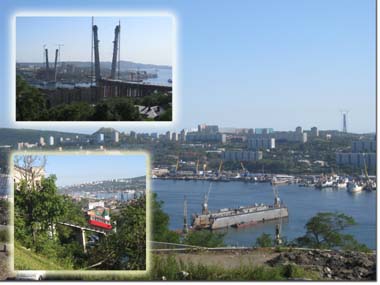 Our
final stop of the day was at the Eagles Nest, a high spot overlooking
the new freeway approach to the cable styed bridge, as the high spot
overlooking the city. It also featured the only Russian funicular east of
Sochi.
Our
final stop of the day was at the Eagles Nest, a high spot overlooking
the new freeway approach to the cable styed bridge, as the high spot
overlooking the city. It also featured the only Russian funicular east of
Sochi.
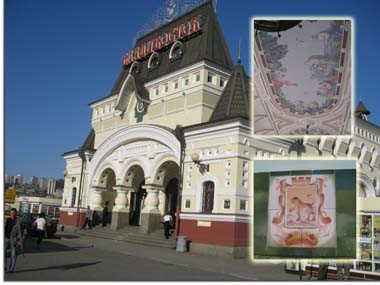
Eventually we got to station,
which was a beautifully restored example of 19th century architecture.
After a brief meeting, with champagne toasts, the assembled band played the train in.
This is it - at milepost 9288 km - the start of the vast journey across
a land three times the size of the United States. On board
everyone was trying to figure out how to put their
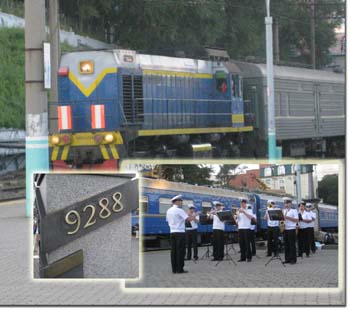 stuff in
their cabins and unpack. Perhaps after dinner it will all become
clear - especially after all the dinner wine! In the effort of
meeting our fellow passengers, we had dinner with a lovely couple from Canberra.
We would find that about one quarter of our tour group is from
Australia. They are a traveling lot, and usually a great deal of fun to be
with.
stuff in
their cabins and unpack. Perhaps after dinner it will all become
clear - especially after all the dinner wine! In the effort of
meeting our fellow passengers, we had dinner with a lovely couple from Canberra.
We would find that about one quarter of our tour group is from
Australia. They are a traveling lot, and usually a great deal of fun to be
with.
Vladivostok is trying to get itself into the 20th
century. But there are some issues. The place was not built
with the automobile in mind, so the streets are narrow. The
construction of the new bridge is reportedly off by 4 meters and Mr. Putin is NOT pleased.
There is horrible
traffic in town, mostly due to construction, but also to city design.
Russian drivers, aren’t as bad as in
the Middle East, but are close.
It is said that if you can drive here,
you can drive anywhere. But we heard that in Egypt, and I'd be
more inclined to believe that area as the defining driving lesson.
But even with the total disregard for lanes and traffic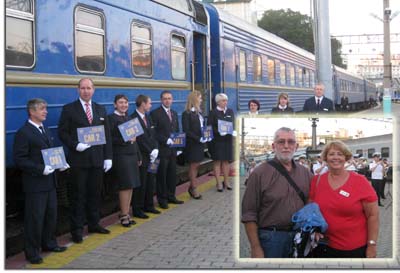 signals, there is little discernible car damage.
Our guide had a PhD in aquatic sciences
and grew up on farm outside
Vladivostok. The world opened to her when the city was opened in
1991. Now, she has had extensive USA travel and is optimistic about Russia's
future. This was a cautious optimism we would see repeated over
and over in the coming weeks.
signals, there is little discernible car damage.
Our guide had a PhD in aquatic sciences
and grew up on farm outside
Vladivostok. The world opened to her when the city was opened in
1991. Now, she has had extensive USA travel and is optimistic about Russia's
future. This was a cautious optimism we would see repeated over
and over in the coming weeks.
For now, we are off on a grand adventure.
Sept 8
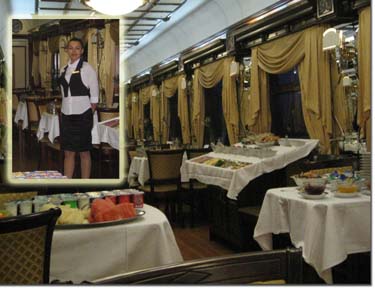 Actually, everyone slept pretty well last night.
The top bunk, though, is a long way from the floor.
It was our introduction to Russian breakfast fare - semolina and kasha.
They are grain based porridges, and think of them as a finer oatmeal.
And as for a luxurious lifestyle - caviar for breakfast. It's the
red caviar, but still. What a treat.
Actually, everyone slept pretty well last night.
The top bunk, though, is a long way from the floor.
It was our introduction to Russian breakfast fare - semolina and kasha.
They are grain based porridges, and think of them as a finer oatmeal.
And as for a luxurious lifestyle - caviar for breakfast. It's the
red caviar, but still. What a treat.
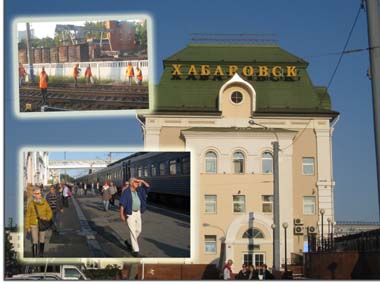
We are heading almost straight north to Khabarovsk where we will take a short city tour. The cabin is small, storage is at a premium. Taking a shower is an adventure. So far we are passing forest. Miles and miles of forest. I’m sure we will see more birch the further west we get, but for now this is primarily deciduous forest, punctuated by an occasional rather humble village. We have been passing trains, both freight and passenger.
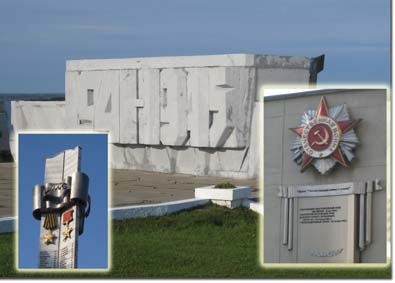 Our bus showed up for the city tour, and we headed out into the
second largest city in Siberia.
The claims to fame here are mining, timber, and fishing.
The city is located on hills over looking the Amur River, which
is the largest in Russia at around 4500 km in length.
It is quite wide.
Khabarovsk itself is quite lovely, although initially, it looked like
all we would do is ride around by bus.
We stopped at a monument over looking the city,
which was dedicated to The Great Patriotic War (WW2).
Our bus showed up for the city tour, and we headed out into the
second largest city in Siberia.
The claims to fame here are mining, timber, and fishing.
The city is located on hills over looking the Amur River, which
is the largest in Russia at around 4500 km in length.
It is quite wide.
Khabarovsk itself is quite lovely, although initially, it looked like
all we would do is ride around by bus.
We stopped at a monument over looking the city,
which was dedicated to The Great Patriotic War (WW2).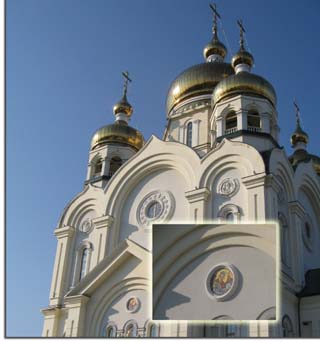 Also along the square was a church, with the typical gold onion domes.
Also along the square was a church, with the typical gold onion domes.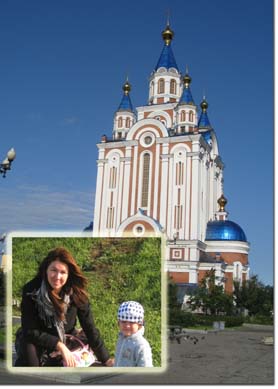
Complete with people just getting out of their apartments and sitting in the sun.
Once we departed the
monument, John, Kent and I bolted on foot for Lenin Square, where the bus
was to pick us up.
So three American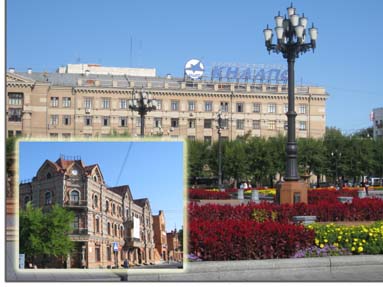 tourists, afoot in a town few in the west have ever heard of. It
was rather refreshing. In fact, I even got tagged to do a short
standup interview for some Russian TV segment. I have no idea what
it was for.
It turned
out to be quite a walk, but it afforded us the ability to get some shots
of the downtown, and 19th century buildings, and the bustle
of the people.
Along the way
was a church topped with a brilliant blue dome, instead of the
traditional gold.
We weren't
certain we were headed in the right direction, but my rudimentary
Russian of “Where is Lenin Square” (gyde Lenin ploschat) seemed to work.
Once there, we
tourists, afoot in a town few in the west have ever heard of. It
was rather refreshing. In fact, I even got tagged to do a short
standup interview for some Russian TV segment. I have no idea what
it was for.
It turned
out to be quite a walk, but it afforded us the ability to get some shots
of the downtown, and 19th century buildings, and the bustle
of the people.
Along the way
was a church topped with a brilliant blue dome, instead of the
traditional gold.
We weren't
certain we were headed in the right direction, but my rudimentary
Russian of “Where is Lenin Square” (gyde Lenin ploschat) seemed to work.
Once there, we
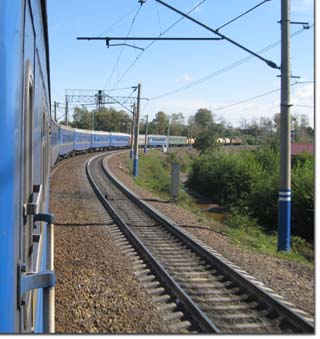 discovered some weddings in progress.
I was afraid we had told the guide a different location, but all
turned out to be correct.
The bus picked us up on the way to the station, and off we went.
discovered some weddings in progress.
I was afraid we had told the guide a different location, but all
turned out to be correct.
The bus picked us up on the way to the station, and off we went.
So we are back on the train, heading west
this time. Our big blue train consists of 15 units, including the
lounge, two restaurant cars and a kitchen car. And except for storage, a
generator car and crew quarters, the rest is sleepers. I would
find out later that the lack of Heritage class cars was due to the fact
that they were being refitted as improved Gold class with a new,
Imperial Suite in each.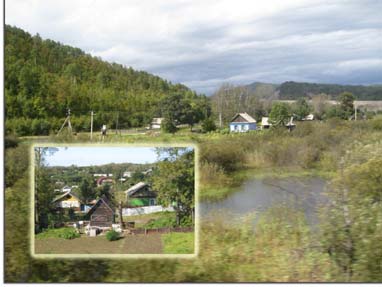
The outskirts of Khabarovsk again yielded photos of the rather rolling hills and small houses along the track.
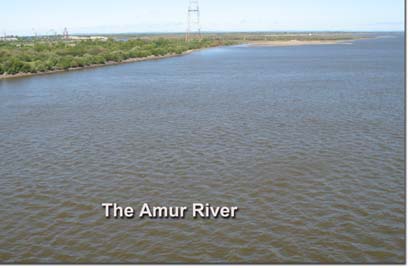
We crossed the Amur, one
of Siberia's major rivers. It was spanned by a 1.6 mile long bridge, and other than an
interview tonight, that’s all that is on my schedule for today.
Sept 9
Well, another bumpy night on the railroad.
Looking out the window, we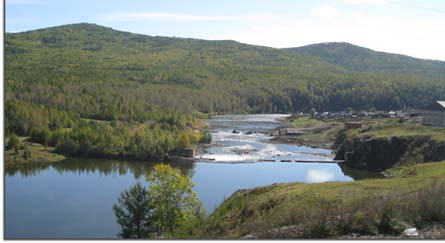 were greeted with a lovely river valley and small towns. The line
east of Lake Baikal generally meanders along the rivers, although I must
say I am ignorant of which one we are following. I think it is the
Shilka. Trust me, I had never heard of it until reading a bit
about the history of Siberia.
were greeted with a lovely river valley and small towns. The line
east of Lake Baikal generally meanders along the rivers, although I must
say I am ignorant of which one we are following. I think it is the
Shilka. Trust me, I had never heard of it until reading a bit
about the history of Siberia.
We are managing in the cabin, doing a dance around each other. It is best to stay in bed until the other party is out of the bathroom. And taking a shower is quite an adventure. We are passing the Siberia I imagined – birch forests, rolling hills, and humble little towns and villages. It would be grim to our way of life to live like this.
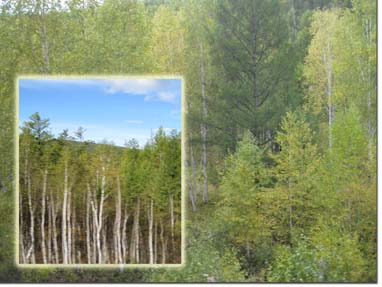 We got an interview with Anna, one of the train managers today,
and she reiterated that Irkutsk and Kazan are the two high spots of the
trip. We
did an interview with Tatiana, the Train
Manager, which will form
the backbone of the narrative.
We are passing lots of small villages, lots of timber, rivers,
and rolling
hills.
Of course, we do get to see lots of traffic
eastbound on the rail line. As the Trans-Siberia is THE major
link between the Pacific and Europe, I have anticipated this traffic.
Oddly, there isn't as much container traffic as I would have
We got an interview with Anna, one of the train managers today,
and she reiterated that Irkutsk and Kazan are the two high spots of the
trip. We
did an interview with Tatiana, the Train
Manager, which will form
the backbone of the narrative.
We are passing lots of small villages, lots of timber, rivers,
and rolling
hills.
Of course, we do get to see lots of traffic
eastbound on the rail line. As the Trans-Siberia is THE major
link between the Pacific and Europe, I have anticipated this traffic.
Oddly, there isn't as much container traffic as I would have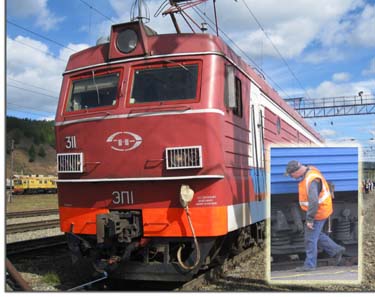 expected.
expected.
We stopped someplace for either fuel or a crew change on the head end. The "car knocker" was busy checking the bearings on each axle. We all came to welcome that musical "tink" indicating a good bearing!
Anna, one of the train managers, started with her Russian lessons at 3:30. Anything at that time of day puts me to sleep, and this was no exception. But Barb p[anticipated and had lots of fun learning rudimentary phrases and Russian folk song, "Kalinka."
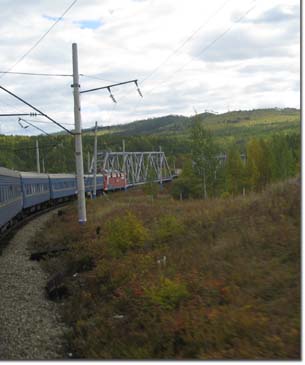
Dinner
was a bit late, as we moved our clocks back an hour.
I must say that the food has been very good –
отличный
(atlichna) – Russian
for excellent.
Off to bed.
The rocking of the train is really quite lulling.
Barb and I did our “small cabin dance
"and off to sleep we
drifted, as the vastness of the Russian steppe rolled past.
Sept 10
Due to the time change, everyone was again up
early.
The valleys are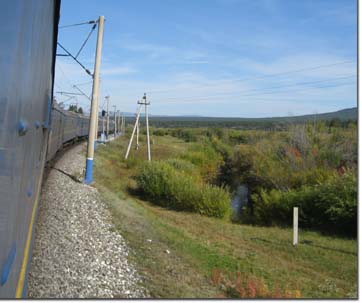 shrouded in mist, and there was hoar frost laying on some of them.
It is a vast, beautiful countryside.
We continue to pass small villages,
all filled with wooden houses. And al with mountains of firewood,
giving testament to the impending winter and mode of heating.
Obviously, there is no centralized heating
in these villages, but there are satellite dishes on most houses!
The
shrouded in mist, and there was hoar frost laying on some of them.
It is a vast, beautiful countryside.
We continue to pass small villages,
all filled with wooden houses. And al with mountains of firewood,
giving testament to the impending winter and mode of heating.
Obviously, there is no centralized heating
in these villages, but there are satellite dishes on most houses!
The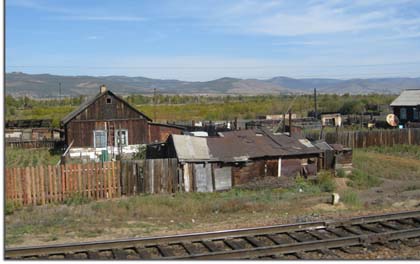 color blue seems to be a favorite.
We later discovered that like barn red, it was the cheapest color
available. And it also reminds the people of the sky.
color blue seems to be a favorite.
We later discovered that like barn red, it was the cheapest color
available. And it also reminds the people of the sky.
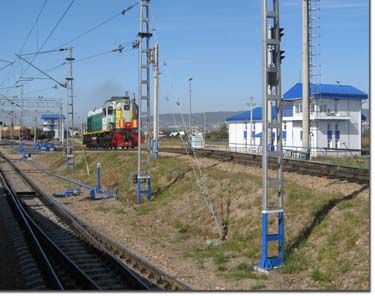 We passed some sort of military installation, with an old Mig-21
on a pedestal.
While it
looked like an airfield, complete with pillbox machine gun posts, there
was no signage indicating what it was or whether it was still in use.
I found out later that it is indeed a
military airfield, out here in the middle of nowhere. The amount of freight traffic is high – probably five trains per
hour.
Of course, it’s not
like you can shove it off to the highway system.
Most of the traffic though, appears to be tanker loads.
We passed an official hump yard.
We passed some sort of military installation, with an old Mig-21
on a pedestal.
While it
looked like an airfield, complete with pillbox machine gun posts, there
was no signage indicating what it was or whether it was still in use.
I found out later that it is indeed a
military airfield, out here in the middle of nowhere. The amount of freight traffic is high – probably five trains per
hour.
Of course, it’s not
like you can shove it off to the highway system.
Most of the traffic though, appears to be tanker loads.
We passed an official hump yard.
The countryside is pretty clean, and unless you get close to a
village,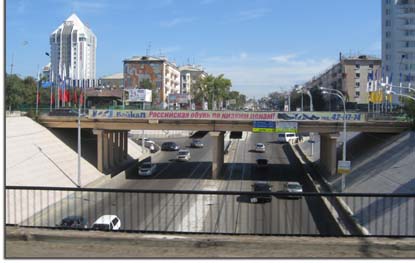 there is no trash – no plastic bags or bottles to be seen.
Occasionally around a village one will see some refuse, but even
then, there isn’t much.
Later.
I stand corrected.
As we get closer to villages and larger towns, there is plenty of
trash.
It consists of the
usual plastic bags and plastic bottles.
Yuch.
If this stuff
was worth money, maybe it would all be cleaned up.
We arrived in Ulan-Ude, where the windows were washed, and we
switched motive power to the opposite end.
After fuel, water, and probably emptying the holding tanks, we
were on our way down the Trans Mongolian Railway to Ulan Bataar.
there is no trash – no plastic bags or bottles to be seen.
Occasionally around a village one will see some refuse, but even
then, there isn’t much.
Later.
I stand corrected.
As we get closer to villages and larger towns, there is plenty of
trash.
It consists of the
usual plastic bags and plastic bottles.
Yuch.
If this stuff
was worth money, maybe it would all be cleaned up.
We arrived in Ulan-Ude, where the windows were washed, and we
switched motive power to the opposite end.
After fuel, water, and probably emptying the holding tanks, we
were on our way down the Trans Mongolian Railway to Ulan Bataar.
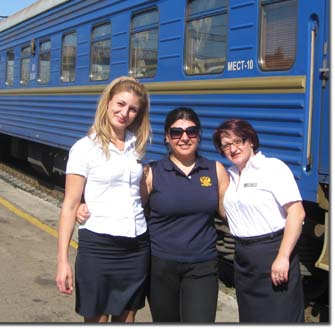
Three of the cabin attendants pose, after taking their turns washing the windows.
The evening promises to be interesting, as we are to remain in
our cabins as we cross from Russia to Mongolia.
This is forecast as a five hour project, with passports
presented, returned, then presented again, and returned.
Needless to say, there is additional paperwork.
The camera gear is all stowed away and hidden.
At least, I hope it is all hidden.
According to the plan, we will be on our way shortly after
midnight.
As I type this, we
are pulling off on a siding.
Sept 11
The evening was disturbed by the border guards
poking their heads in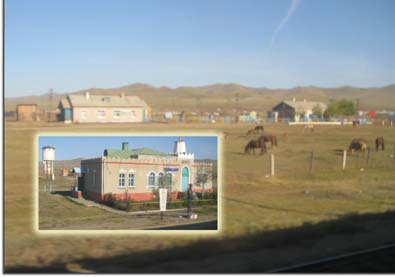 and checking passports and – for non USA citizens
– visas.
This was followed
by the worst track of the ride to date.
It was slow going, on bad ordered rails.
It was rough, out of level, and generally was not conducive to a
good night’s rest.
The
landscape has changed to vast open grasslands, with herds of cattle,
horses, and sheep, all of which are tended by the Mongolian version of
the American cowboy.
There
are a lot of gers, the round
and checking passports and – for non USA citizens
– visas.
This was followed
by the worst track of the ride to date.
It was slow going, on bad ordered rails.
It was rough, out of level, and generally was not conducive to a
good night’s rest.
The
landscape has changed to vast open grasslands, with herds of cattle,
horses, and sheep, all of which are tended by the Mongolian version of
the American cowboy.
There
are a lot of gers, the round
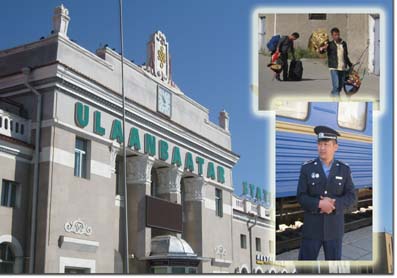 houses of the nomadic Mongols.
What settlements we did pass, were rather well kept, all fenced
in, and generally looked far better cared for than the Russian shacks of
the last few days.
However,
there did seem to be an abundance of trash in the form of plastic bags
and bottles.
Eventually we
arrived in Ulan Bataar, the capitol of Mongolia.
houses of the nomadic Mongols.
What settlements we did pass, were rather well kept, all fenced
in, and generally looked far better cared for than the Russian shacks of
the last few days.
However,
there did seem to be an abundance of trash in the form of plastic bags
and bottles.
Eventually we
arrived in Ulan Bataar, the capitol of Mongolia.
The country has a population of around 2.6 million, with roughly
1 million living here.
None
of us expected what we found, which was a modern city with multinational
corporations, upscale shops and boutiques, and a great deal of construction.
Traffic was somewhat heavy, but the streets were wide and
bustling.
Mongolia has great
mineral wealth, in the form of coal, copper, lithium and cadmium.
And all that wealth is being used to build up the capitol and the
country.
Schooling is the
Cambridge version, with a 12 year basic education, followed by
university.
To keep the
children of the outlying nomadic tribes in a stable educational
environment, the schools have dormitories, which start at age 5 (I
think) for the school sessions.
Note that the signs are in Mongolian, which is similar to
Russian, but a different (added and dropped letters) and English.
The democratic government decided to go with the two languages,
feeling that English had the largest international penetration.
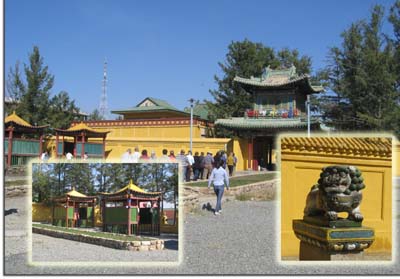
Our visit to the main train station was short, as we were bused to the Gandan Monastery. We saw some of the temples, and hordes of street vendors, all vying for the tourist dollars. This site was established in 1838, and at it’s peak, housed some 5,000 monks. The place was shuttered during the communist years, but reopened in full in 1990.
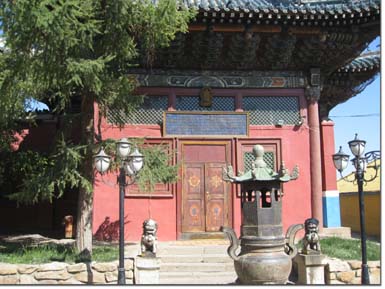
Temples and more temples. And everyone
trying to sell you something to take home. Whether it was a
"genuine hand painted"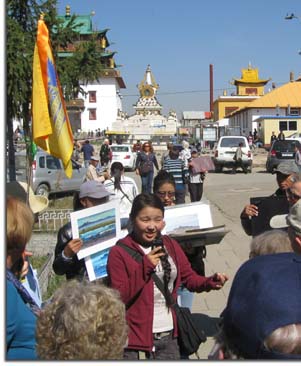 scene or pray bells, there was plenty of opportunity to make up for lost
souvenir shopping time.
scene or pray bells, there was plenty of opportunity to make up for lost
souvenir shopping time.
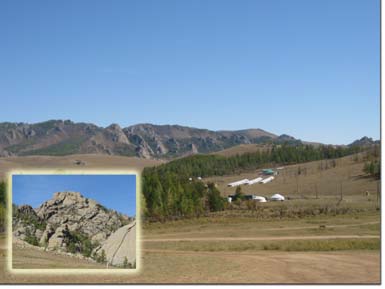 From there
we were bused for about a 90 minute ride to one of Mongolia’s national
parks – the Terelj National Park.
Situated in a valley of the Twl River (one of the three major
Mongolian rivers – it was vast, wild and stunning in its beauty.
There were ger tourist camps, and we got to visit several.
From there
we were bused for about a 90 minute ride to one of Mongolia’s national
parks – the Terelj National Park.
Situated in a valley of the Twl River (one of the three major
Mongolian rivers – it was vast, wild and stunning in its beauty.
There were ger tourist camps, and we got to visit several.
A traditional ger is obviously round, and come in a variety of
sizes.
They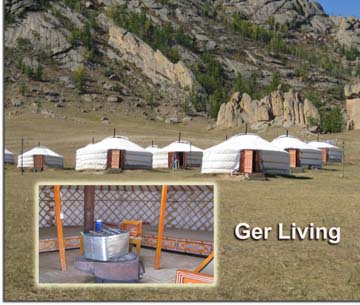 have [virtual]
walls, with the left side space allocated to a [wall] of washing and
clothing storage, several [walls] of bedrooms, and always to the right
of the doorway, a [wall] of kitchen.
The women and womanly things are always to the right.
The initial one we were shown had a diameter of maybe 20 feet, and
would house 10 people.
Cooking was all done on the stove, situated in the center.
I found it interesting that there was a small refrigerator,
freezer, and TV set.
I have no idea if
they were powered, or simply used block ice.
The walls are felt, externally covered with a
have [virtual]
walls, with the left side space allocated to a [wall] of washing and
clothing storage, several [walls] of bedrooms, and always to the right
of the doorway, a [wall] of kitchen.
The women and womanly things are always to the right.
The initial one we were shown had a diameter of maybe 20 feet, and
would house 10 people.
Cooking was all done on the stove, situated in the center.
I found it interesting that there was a small refrigerator,
freezer, and TV set.
I have no idea if
they were powered, or simply used block ice.
The walls are felt, externally covered with a
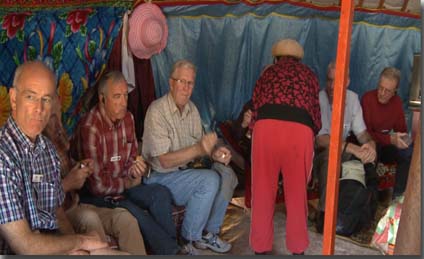 canvas, and
internally with skins or rugs.
Built around a wood lattice, the whole thing can be broken down
and reassembled in about a half hour for each function.
Obviously, that time was for those with experience.
I’d be looking for the “insert tab A into slot B” booklet!
canvas, and
internally with skins or rugs.
Built around a wood lattice, the whole thing can be broken down
and reassembled in about a half hour for each function.
Obviously, that time was for those with experience.
I’d be looking for the “insert tab A into slot B” booklet!
The countryside was really beautiful, with valleys of grassland, jutting mountain peaks, and a stark blue sky. After a ride back into Ulan Bataar, we stopped at the Bogd Khan Palace museum. The robes and possessions of the last emperor and empress of Mongolia. Truthfully, we were a bit burned out by this time.
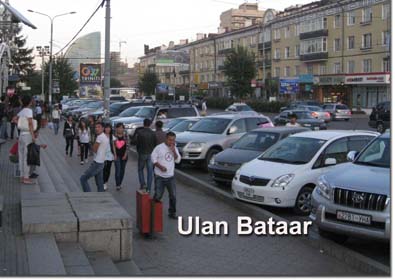 Next stop, the shopping portion, at a cashmere outlet store, and
a major department store.
There was a great deal of high end shopping available here.
Next stop, the shopping portion, at a cashmere outlet store, and
a major department store.
There was a great deal of high end shopping available here.
We did manage to get some shots of Sukhe Bator Square, the main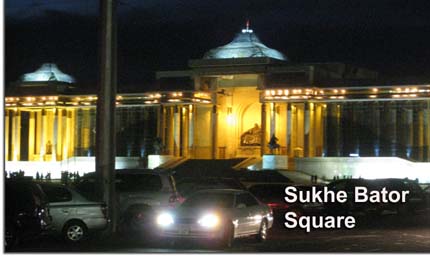 government square, after being chased off once.
While the air pollution was pretty severe, Ulan Bataar was much
more enjoyable than we had expected.
It was a thriving, bustling city.
Someone said in 20 years, this place would look like Seoul.
If it keeps going, I believe it.
government square, after being chased off once.
While the air pollution was pretty severe, Ulan Bataar was much
more enjoyable than we had expected.
It was a thriving, bustling city.
Someone said in 20 years, this place would look like Seoul.
If it keeps going, I believe it.
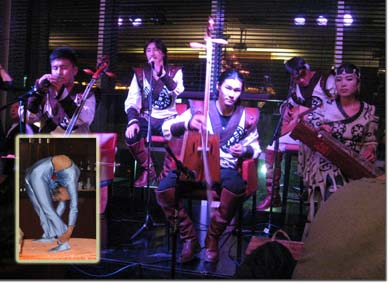 Dinner was in an upscale restaurant in a new, modern high rise,
with the obligatory folk music performance, which turned out to be quite
enjoyable.
The group demonstrated a type of deep
throated singing, the likes of which I had never heard before.
Think of it has a string bass tone produced by the human voice. It
was quite remarkable. The musical
instruments were also interesting.
There is a traditional two string horse headed fiddle, as well as
a double necked fiddle, each with two strings.
There was a contortionist that was simply amazing. Back to the train.
Dinner was in an upscale restaurant in a new, modern high rise,
with the obligatory folk music performance, which turned out to be quite
enjoyable.
The group demonstrated a type of deep
throated singing, the likes of which I had never heard before.
Think of it has a string bass tone produced by the human voice. It
was quite remarkable. The musical
instruments were also interesting.
There is a traditional two string horse headed fiddle, as well as
a double necked fiddle, each with two strings.
There was a contortionist that was simply amazing. Back to the train.
Sept 12
 After another night of the same bad track, this
time headed north, we again did our border guard thing, and headed back
into Russia.
We were
After another night of the same bad track, this
time headed north, we again did our border guard thing, and headed back
into Russia.
We were
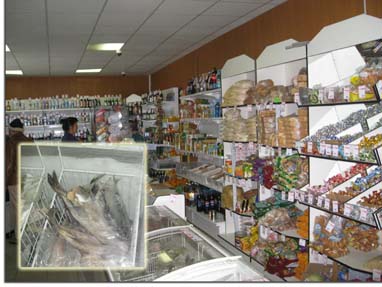 stopped
at the border, Naushi, for about half a day while papers were checked,
new head end power was put on and tanks filled, drained, replenished and
the like. That gave all of use some platform time. Of main
interest was a small grocery store - think mini-mart. One whole
wall was just vodka. Nothing but vodka. Obviously, it is a
big seller.
There were a couple of other local shops,
which were pretty sparse.
What do people do here other than man the border?
stopped
at the border, Naushi, for about half a day while papers were checked,
new head end power was put on and tanks filled, drained, replenished and
the like. That gave all of use some platform time. Of main
interest was a small grocery store - think mini-mart. One whole
wall was just vodka. Nothing but vodka. Obviously, it is a
big seller.
There were a couple of other local shops,
which were pretty sparse.
What do people do here other than man the border?
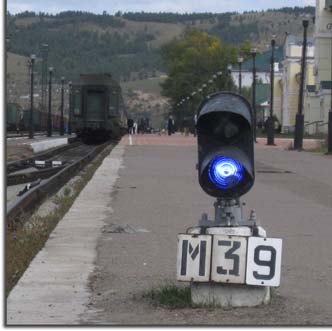
Eventually, we were on our way, this time for only a short distance, as we headed into the capital of Buryatia, Ulan-Ude.
Today promises
a short city tour in Ulan Ude, a city that our tour guide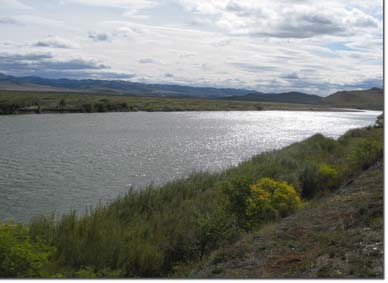 said was
rather Soviet in look and construction.
There was fantastic scenery on the way to Ulan Ude, capitol of the Buryate
Republic.
said was
rather Soviet in look and construction.
There was fantastic scenery on the way to Ulan Ude, capitol of the Buryate
Republic.
Put off train and taken to Tarbagatai, a village
of the Old Believers. I had never heard of these people, but this was a fascinating little
outing. Apparently there was a split in the Christian Church in
central Europe, and these folks were (of course) exiled to Siberia for
practicing their version. So they
walked from Poland and the Ukraine; about 10,000 km, and set up shop
here, outside of Ulan Ude. There are quaint
had never heard of these people, but this was a fascinating little
outing. Apparently there was a split in the Christian Church in
central Europe, and these folks were (of course) exiled to Siberia for
practicing their version. So they
walked from Poland and the Ukraine; about 10,000 km, and set up shop
here, outside of Ulan Ude. There are quaint
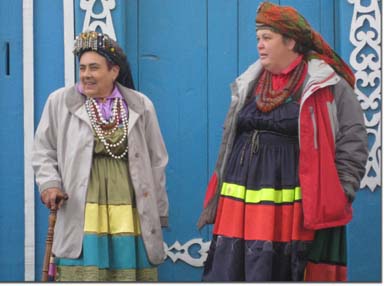 wooden houses,
many with blue paint
(cheap and was color of the sky), and many in other colors and designs.
We were shown through a typical homestead, which had both summer and winter houses,
complete with flowers, gardens and outbuildings. The main show was
in the museum of original
wooden houses,
many with blue paint
(cheap and was color of the sky), and many in other colors and designs.
We were shown through a typical homestead, which had both summer and winter houses,
complete with flowers, gardens and outbuildings. The main show was
in the museum of original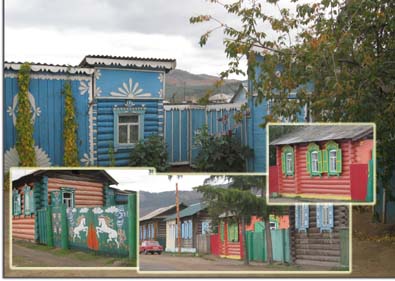 artifacts,
where we had dinner,
and a delightful, raucous musical show. Believe me, these folks
could take this gig on the road.
artifacts,
where we had dinner,
and a delightful, raucous musical show. Believe me, these folks
could take this gig on the road.
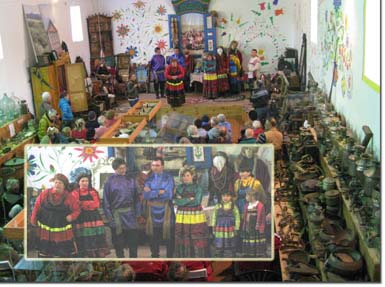
But for the tourists, I didn't see anything going on here. In Soviet times this place had a candy factory, which now closed, and looking apocalyptic. There were wonderful scenes here, but wow, what a rough life.
By the time we got into Ulan Ude,
it was dark. So Lenin’s giant head, all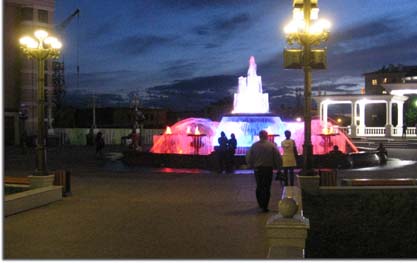 46 tons
of it, largest in the world, was practically invisible. You would
think they would put some lights on the guy, but then, maybe they aren't
so proud of him anymore.
Instead, a fountain was more colorful. Does that signify
something?
46 tons
of it, largest in the world, was practically invisible. You would
think they would put some lights on the guy, but then, maybe they aren't
so proud of him anymore.
Instead, a fountain was more colorful. Does that signify
something?
On the plus side I found potato
chips.
Weather has turned
cold – upper 40s.
Sept 13
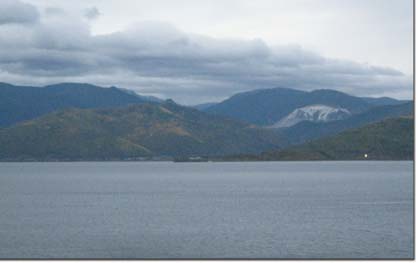 The
day started with rain and fog.
Brief patches of color would show up, but then again be obscured.
But we are at Lake Baikal, which holds 20% of the world’s fresh
water.
The
day started with rain and fog.
Brief patches of color would show up, but then again be obscured.
But we are at Lake Baikal, which holds 20% of the world’s fresh
water.
We were able to get
on the engine, not only for a cab ride, but for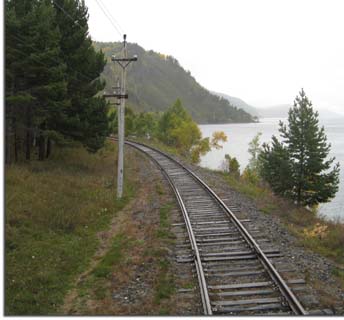 multiple front platform
and side catwalk rides.
The
CircumBailkal Railway is now just a tourist line, having been by passed
by the main line.
But it is
still an engineering marvel, with around 250 bridges and 35 tunnels or
something.
The line hugs the
shore of the south side of the lake.
multiple front platform
and side catwalk rides.
The
CircumBailkal Railway is now just a tourist line, having been by passed
by the main line.
But it is
still an engineering marvel, with around 250 bridges and 35 tunnels or
something.
The line hugs the
shore of the south side of the lake.
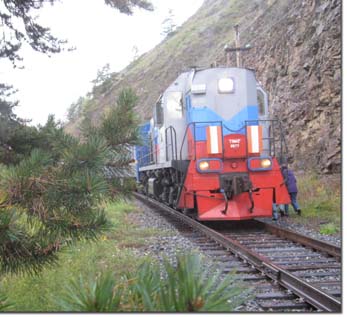
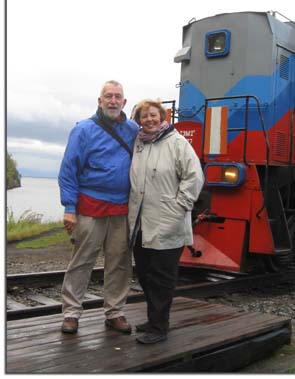
And just to show that we were really here!
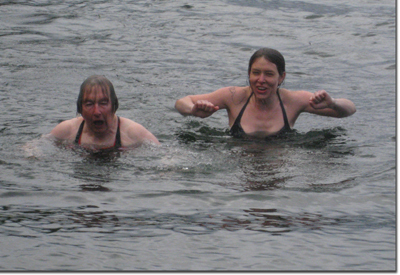
We stopped at the half way point, Polovina, and
there
were five adventurous travelers that went swimming in the very cold lake.
My brother and I went in up to our knees, so I guess,
as legend states,
we will have about ten years
added to our life spans. 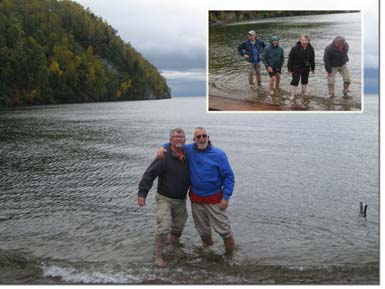 Any
more exposure would have definitely shortened my life, as the water was
– as one of the younger passengers said, “F*****g freezing.” But
there were always the vodka shots to give one courage and ward off the
chill.
Any
more exposure would have definitely shortened my life, as the water was
– as one of the younger passengers said, “F*****g freezing.” But
there were always the vodka shots to give one courage and ward off the
chill.
We bundled up, and I hoofed it down to an old 2-10-0 steam
display and
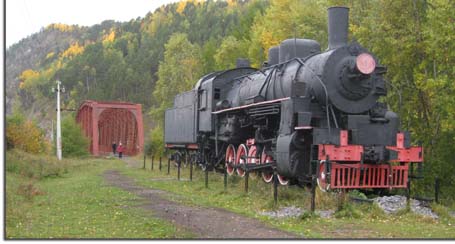 one of the original bridges.
This must have been a photographer's
paradise when steam was in vogue. All the bridges and tunnels,
plus short trains and these little engines. Wow.
one of the original bridges.
This must have been a photographer's
paradise when steam was in vogue. All the bridges and tunnels,
plus short trains and these little engines. Wow.
Many rivers flow into Lake Baikal, but only one flows out. Baikal is the deepest lake in the world at just under a mile at the deepest spot. It is also home to some animal varieties only found here, such as the fresh water seal, and several varieties of fish. John got into a speedboat, and shot some passing footage of the train, as we all had lunch. Then we got into Port Baikal, which in the early days was where the ferry would take the train cars across the Angara River to Listvyanka Village.
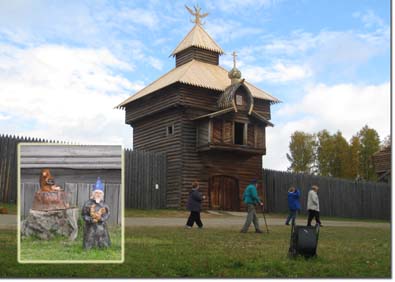 We visited the
Circumbaikal Railway Museum, and then took a boat across the river.
A visit to an aquarium, and the Museum of Wooden Architecture,
which really was an out door museum of how an original Siberian Village
would look.
Log houses,
small windows, low doorways, and one big stone or brick hearth made up
the main living quarters.
Life was pretty tough.
Back
to the train, barbeque dinner on board due to the weather, which has now
turned sunny.
Dinner
consisted of omul, a local fish only found here.
We visited the
Circumbaikal Railway Museum, and then took a boat across the river.
A visit to an aquarium, and the Museum of Wooden Architecture,
which really was an out door museum of how an original Siberian Village
would look.
Log houses,
small windows, low doorways, and one big stone or brick hearth made up
the main living quarters.
Life was pretty tough.
Back
to the train, barbeque dinner on board due to the weather, which has now
turned sunny.
Dinner
consisted of omul, a local fish only found here.
Sept 14
The train stopped in a yard for a bit last night.
Everyone had trouble
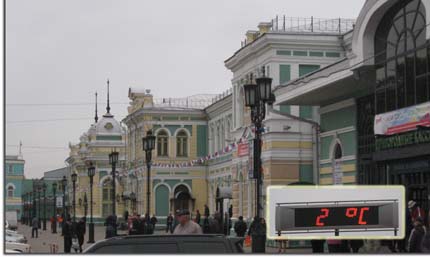 sleeping.
There was no rocking or noise and it was really quiet.
Like really, really quiet. We arrived in Irkutsk at the central station.
This is Siberia, so appropriately, we had snowflakes.
The temperature was 1, but warmed to 2 degrees
Celsius.
sleeping.
There was no rocking or noise and it was really quiet.
Like really, really quiet. We arrived in Irkutsk at the central station.
This is Siberia, so appropriately, we had snowflakes.
The temperature was 1, but warmed to 2 degrees
Celsius.
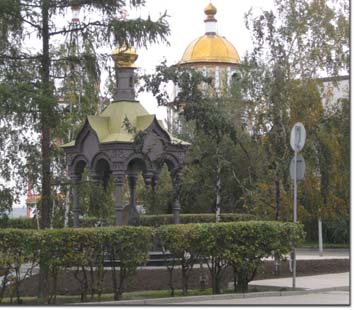 A whole day off the train again.
Off to the obligatory churches and the
like. I'm still getting to the point of wanting to see a tractor
factory. Why do these tours always want to show you churches and
mosques? I really don't care.
A whole day off the train again.
Off to the obligatory churches and the
like. I'm still getting to the point of wanting to see a tractor
factory. Why do these tours always want to show you churches and
mosques? I really don't care.
Shot a few down town statues (founder of Trans-Siberian
RR, founder of city) and
a couple of churches on a cold, grey,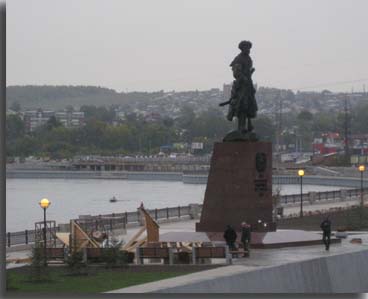 windy morning.
windy morning.
We were initially
mystified by all the locks on the bridge railings. Apparently
these are done by newly weds as a sign of their
marital vows.
Put a lock on the railing, and throw the key into the
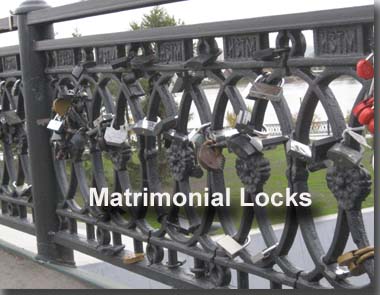 river.
The divorce rate is around 40%. Even so, it is a sign of
commitment. And some of these locks should be shown to Master
Lock, as they were substantial chunks of metal.
river.
The divorce rate is around 40%. Even so, it is a sign of
commitment. And some of these locks should be shown to Master
Lock, as they were substantial chunks of metal.
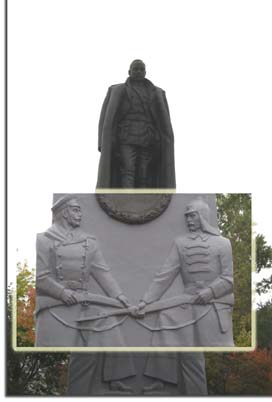
Yet another statue appeared, this time of General Kolchak – former leader of the White Russian Army. The two bias reliefs indicate a joining of forces, but if memory serves me correctly, the Bolsheviks shot him. Now he has a statue. Times change.
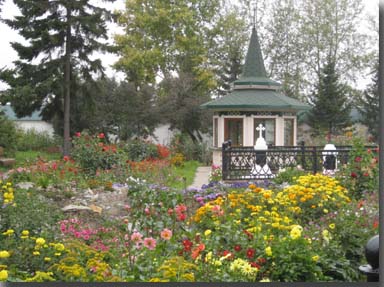 More
monasteries and cathedrals. At least the gardens were pretty.
More
monasteries and cathedrals. At least the gardens were pretty.
We made an internet stop and were sort of
struck by these pictures.
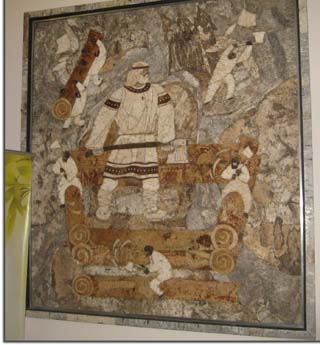 They are actually made up of birch bark. Kind of a neat thing and
sort of a folk art type of thing.
They are actually made up of birch bark. Kind of a neat thing and
sort of a folk art type of thing.
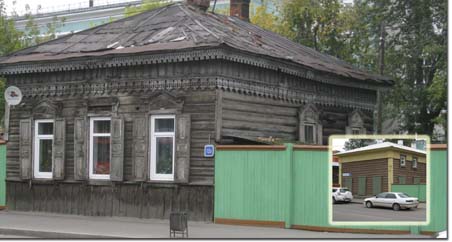 This is
supposed to be the place of wooden houses, and most are in a sad state,
really needing restoration.
But there is no funding.
All
are preservation places, but some mysteriously burn.
No plumbing or running water for the most part.
Today was 350 year festival, so there
was lots of celebration and police
around.
We did a standup after
lunch at a hotel.
Getting
the driver to turn off the bus engine was a test of my Russian phrase
book.
John went to the
market, which was kind of a bust, as there were a lot of guys in black
jackets just hanging about.
He said it reminded him of a Mafia film.
I went to the Irkutsk art gallery, which
This is
supposed to be the place of wooden houses, and most are in a sad state,
really needing restoration.
But there is no funding.
All
are preservation places, but some mysteriously burn.
No plumbing or running water for the most part.
Today was 350 year festival, so there
was lots of celebration and police
around.
We did a standup after
lunch at a hotel.
Getting
the driver to turn off the bus engine was a test of my Russian phrase
book.
John went to the
market, which was kind of a bust, as there were a lot of guys in black
jackets just hanging about.
He said it reminded him of a Mafia film.
I went to the Irkutsk art gallery, which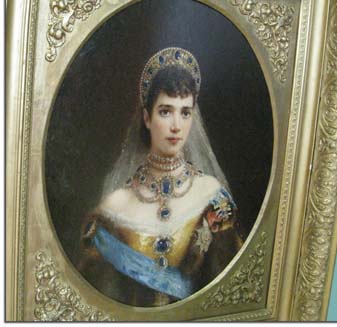 was interesting for
about 10 minutes.
Unfortunately, we stayed longer.
What most of the men wanted to see was the aircraft
bone yard or
museum we passed at the airport.
There looked to be some great Soviet fighter, transport and other
aircraft on display.
That
goes on my comment card.
Saw
some more Russian wooden houses, but in a restored district.
We could only walk half way in to take photos.
Strange place.
On the
Prince Volkonsky House,.
He
was a Decemberist (see period after war of 1823, Russian group tried to
overthrow the Czar, five hanged, rest exiled to Siberia).
His wife followed him and spent her life trying to win his
release.
She built a nice place,
and added a great deal to the culture of Irkutsk. We were treated
to a concert of Russian classical music (which was rather
charming).
Still in town, we had dinner in an upscale restaurant with delightful dinner companions
from Yakima, Washington.
We got back to the
train early, but the train was mis-scheduled into the station. The
train was still in yard and had we had to be bused from main street to
the yard, where we walked along the tracks to get back to our home away
from home.
This was a long day.
Tomorrow we are again on board all day.
was interesting for
about 10 minutes.
Unfortunately, we stayed longer.
What most of the men wanted to see was the aircraft
bone yard or
museum we passed at the airport.
There looked to be some great Soviet fighter, transport and other
aircraft on display.
That
goes on my comment card.
Saw
some more Russian wooden houses, but in a restored district.
We could only walk half way in to take photos.
Strange place.
On the
Prince Volkonsky House,.
He
was a Decemberist (see period after war of 1823, Russian group tried to
overthrow the Czar, five hanged, rest exiled to Siberia).
His wife followed him and spent her life trying to win his
release.
She built a nice place,
and added a great deal to the culture of Irkutsk. We were treated
to a concert of Russian classical music (which was rather
charming).
Still in town, we had dinner in an upscale restaurant with delightful dinner companions
from Yakima, Washington.
We got back to the
train early, but the train was mis-scheduled into the station. The
train was still in yard and had we had to be bused from main street to
the yard, where we walked along the tracks to get back to our home away
from home.
This was a long day.
Tomorrow we are again on board all day.
ept 15
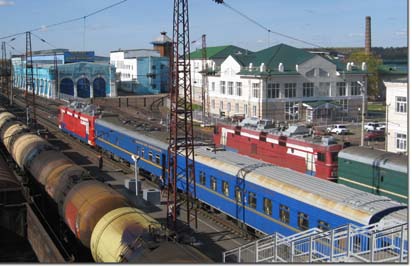 Today was a welcome, quiet day on board.
We started with several standups – or sit downs – in the bar car,
followed by idle time just spent watching the golden birch forested
countryside fly past.
There
are more little villages, as we move further to the west.
More rail yard appeared, as we once
again changed engines, crews and topped our tanks.
Today was a welcome, quiet day on board.
We started with several standups – or sit downs – in the bar car,
followed by idle time just spent watching the golden birch forested
countryside fly past.
There
are more little villages, as we move further to the west.
More rail yard appeared, as we once
again changed engines, crews and topped our tanks.
Practically every
station has an old steam locomotive on a display stand,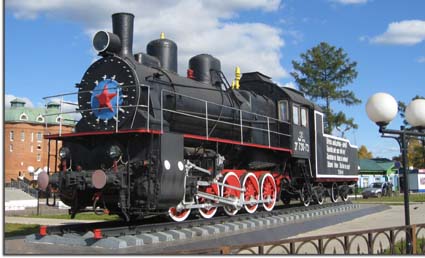 usually one of these 0-10-0 type. The Russians must have had a
gazillion of these things. I'll grant you though, that they are
all pretty nicely displayed and kept up, unlike the USA, where the
displays just get vandalized and/or rust away.
usually one of these 0-10-0 type. The Russians must have had a
gazillion of these things. I'll grant you though, that they are
all pretty nicely displayed and kept up, unlike the USA, where the
displays just get vandalized and/or rust away.
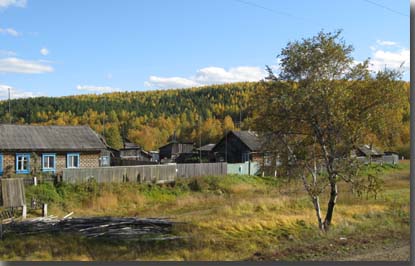 There is an amazing amount of what appears to be either abandoned
or unused factories or other large manufacturing facilities.
It is amazing in looking at this, at the poor housing and living
conditions, just how we were in such fear of these guys.
The country is so large, it just seems unmanageable.
About 80% of all people live in the cities, leaving wide, vast
expanses of the country side be appear native and untouched.
There is an amazing amount of what appears to be either abandoned
or unused factories or other large manufacturing facilities.
It is amazing in looking at this, at the poor housing and living
conditions, just how we were in such fear of these guys.
The country is so large, it just seems unmanageable.
About 80% of all people live in the cities, leaving wide, vast
expanses of the country side be appear native and untouched.
As I mentioned, this was
just a quiet day to reflect and watch the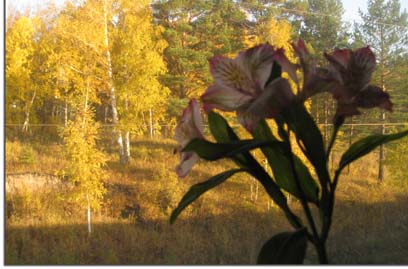 passing birches. They are all decked out in autumnal colors, and
there are miles and miles of them.
passing birches. They are all decked out in autumnal colors, and
there are miles and miles of them.
The rail system is in great repair and well maintained.
The people are cautious in their optimism, but most seem to feel
that for things to get better, there has to be big changes in the
corruption and power at the top of the government.
Towns and cities are apartment flat after apartment flat.
But is the units are individually owned, it is a mixture of well
cared for, and trashed.
The
place looks poor, run down, and neglected.
Old cars, rusting sheet metal, fallen concrete walls, idle cranes
– how will they ever get things together?
We are at mile post 4225.
Just passed a modern oil storage facility.
Russia is a land of contradictions.
Sept 16
I seem to have run out of steam today. 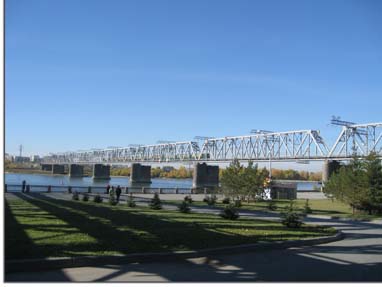 We pulled into Novosibirsk, our final stop in Siberia, about 40
minutes late.
That cut into
the tour time.
The city is
quite modern, having been founded in the early 1900s?.
Originally, it was brought into being as the place where the
Trans Siberian Railway crossed the Ob River, one of the three longest
rivers in Siberia.
So the
streets are wide, and the building all fairly new.
We pulled into Novosibirsk, our final stop in Siberia, about 40
minutes late.
That cut into
the tour time.
The city is
quite modern, having been founded in the early 1900s?.
Originally, it was brought into being as the place where the
Trans Siberian Railway crossed the Ob River, one of the three longest
rivers in Siberia.
So the
streets are wide, and the building all fairly new.
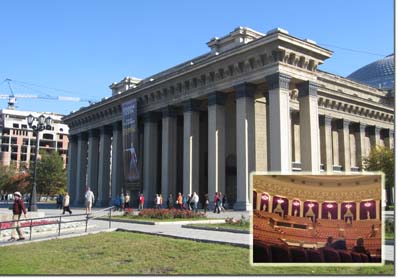 We had a brief tour of the Opera House, one of the best in
Russia, and of course, Lenin and his buddies. There was talk of
tearing the statue down, but people felt that he was a part of history,
so his visage remains.
We had a brief tour of the Opera House, one of the best in
Russia, and of course, Lenin and his buddies. There was talk of
tearing the statue down, but people felt that he was a part of history,
so his visage remains.
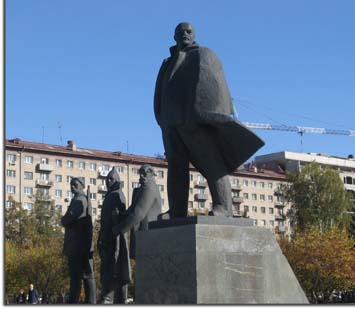
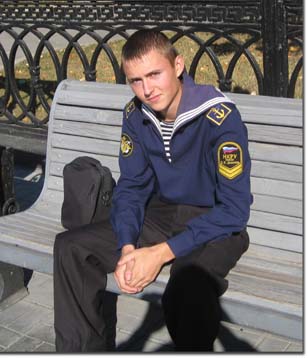 A
sailor, far from home? I didn't know enough Russian to ask him,
and he didn't volunteer any information. But he looked a bit
forlorn just sitting in the sun, in the park, in the shadow of Vladimir
ilyich.
A
sailor, far from home? I didn't know enough Russian to ask him,
and he didn't volunteer any information. But he looked a bit
forlorn just sitting in the sun, in the park, in the shadow of Vladimir
ilyich.
The bus ride next went out to the Academic Center, which was located some
distance from town.
In
around 1941, the Russians decided to set up and academic center, with
five specialties – mathematics, geology, physics, humanities, and ??.
The idea was to get a lot of academicians in one place for cross
breeding of ideas, and to do multifaceted research.
The place sort of languished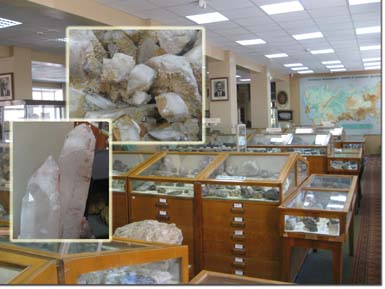 due to WW2, and until
Khrushchev saw
the academic centers in the United States.
Then the place really stated to get funding.
It is built in the middle of a large forest, with apartments,
research and academic facilities.
The University system is considered to be one of the best in
Russia.
We spent some time
at the Geological display, which allowed people to purchase Charoite,
which is a stone only found in around here.
due to WW2, and until
Khrushchev saw
the academic centers in the United States.
Then the place really stated to get funding.
It is built in the middle of a large forest, with apartments,
research and academic facilities.
The University system is considered to be one of the best in
Russia.
We spent some time
at the Geological display, which allowed people to purchase Charoite,
which is a stone only found in around here.
That cut into our time at
the train museum, which was a lot more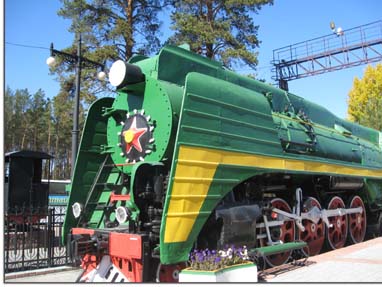 interesting to most of the men.
The display was quite nice, with locomotives, carriages, and
specialty cars.
I will admit that the Russians really did have a couple of great color
schemes for their engines. Even today, the units are all bright
and nicely decorated. They may look a bit 1950ish, but they are
colorful
interesting to most of the men.
The display was quite nice, with locomotives, carriages, and
specialty cars.
I will admit that the Russians really did have a couple of great color
schemes for their engines. Even today, the units are all bright
and nicely decorated. They may look a bit 1950ish, but they are
colorful
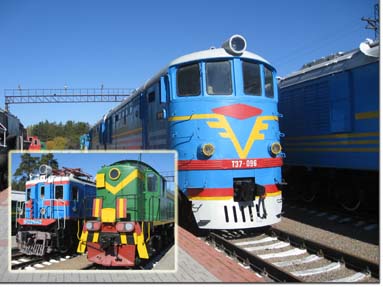
Unfortunately, we just did not have the time to do it justice. Plus there was a museum of old automobiles, that would have been fascinating. Perhaps another time. The crew has to switch buses several times today, as by getting on another bus, we sort of messed up the lunch count plans.
It all worked out in the end, but the bus driver did some amazing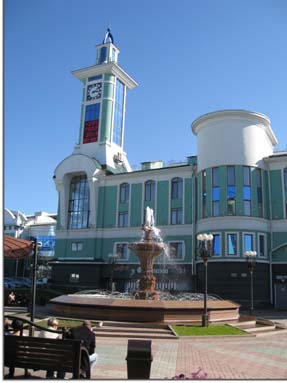 maneuvering in tight streets.
We had a bit of a concert, and then
had "free time." Which people used to get on the free Wi-Fi at a
local hotel, or just do some last minute souvenir shopping.
maneuvering in tight streets.
We had a bit of a concert, and then
had "free time." Which people used to get on the free Wi-Fi at a
local hotel, or just do some last minute souvenir shopping.
And at 3:30, on the dot, we departed and are speeding our way
toward Yekaterinburg.
Tonight's dinner was traditional Russian costume
dress up for the staff.
It was also accompanied by four different flavors of vodka.
You would think that the bar car would be rockin’ after dinner,
but everyone pretty much has one drink and goes to bed.
Sept 17
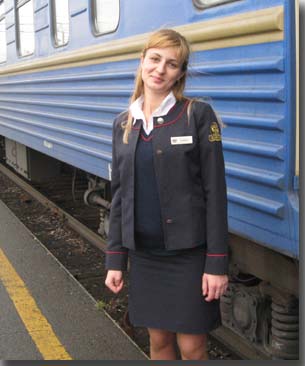 We
were on board all morning, so I had a chance to catch up on
photos and transcribed the Tatiana interview.
That will mean less to do when I get
back to Wisconsin. But we did have some platform time someplace,
which allowed for a photo of the Car 6 provodnik.
We
were on board all morning, so I had a chance to catch up on
photos and transcribed the Tatiana interview.
That will mean less to do when I get
back to Wisconsin. But we did have some platform time someplace,
which allowed for a photo of the Car 6 provodnik.
Stopped in Yekaterinburg (formerly
Sverdlovsk)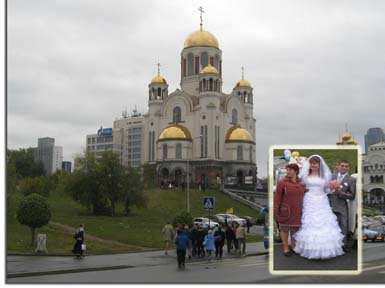 around 2 PM.
This is a beautiful city, even in the rain.
We visited the Church on the Spilled Blood which was
built on the site of the Romanov assassinations.
Today is Saturday, so that means lots of weddings.
Russian weddings are usually three day
affairs. There is a civil ceremony on Fridays, and then the
wedding party travels from spot to spot taking lots of photos.
Usually there are lots of short, short skirts, and high high heels.
We are still seeing a lot of right hand drive cars.
My initial impression is that this is
a very pretty city, with lots of green space but loads of heavy
traffic.
The roads were
wide, but jammed.
We saw the
Afghanistan war memorial, but didn’t stop.
John went there as a part of another tour, and
around 2 PM.
This is a beautiful city, even in the rain.
We visited the Church on the Spilled Blood which was
built on the site of the Romanov assassinations.
Today is Saturday, so that means lots of weddings.
Russian weddings are usually three day
affairs. There is a civil ceremony on Fridays, and then the
wedding party travels from spot to spot taking lots of photos.
Usually there are lots of short, short skirts, and high high heels.
We are still seeing a lot of right hand drive cars.
My initial impression is that this is
a very pretty city, with lots of green space but loads of heavy
traffic.
The roads were
wide, but jammed.
We saw the
Afghanistan war memorial, but didn’t stop.
John went there as a part of another tour, and
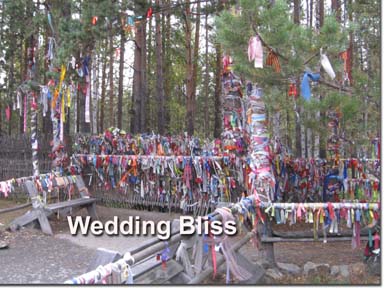 he
said it was pretty sobering.
he
said it was pretty sobering.
The rest of us went to the boundary marker between Europe and Asia. There were more wedding related things here, with ribbons tied to trees as a sign of commitment and good luck.
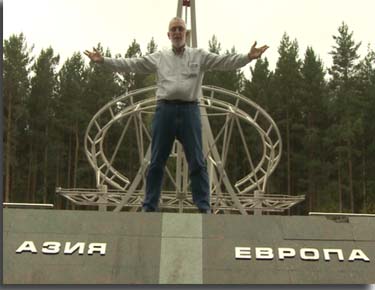
Initially, I thought that this
boundary
marker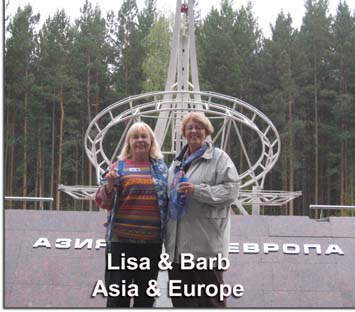 thing would be kind of hokey, but it was a rather neat experience.
After all, how many people can stand between Europe and Asia at the same
time? Plus there was champagne as you did so.
thing would be kind of hokey, but it was a rather neat experience.
After all, how many people can stand between Europe and Asia at the same
time? Plus there was champagne as you did so.
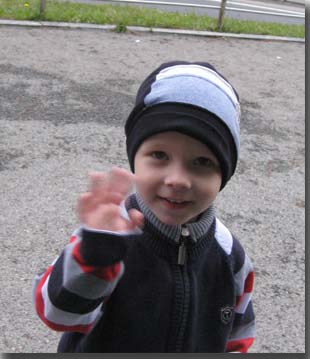
Even the little kids thought it was kind of cool. Or maybe it was us they liked!
Back on the bus, back into town, stopped at small railway museum,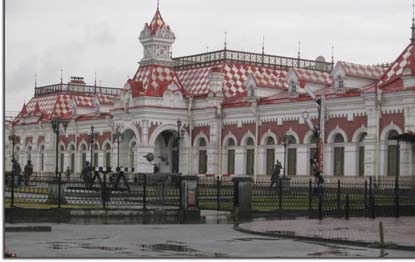 which was kind of humble, but nicely housed and presented.
It just contained artifacts.
Only one
more full day on board.
which was kind of humble, but nicely housed and presented.
It just contained artifacts.
Only one
more full day on board.
Sept 18
It was a very rough ride last night,
and even with an extra 2 hours of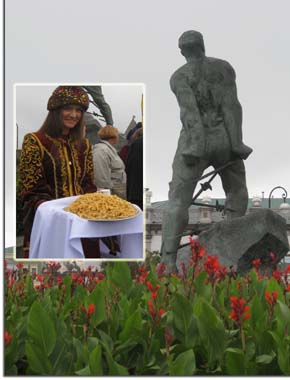 sleep, we
are all tired. I think I speak for pretty much everyone when I say that
I'm glad trip is almost over. But it has been amazing.
Today we toured Kazan, and were warmly greeted at the kremlin.
sleep, we
are all tired. I think I speak for pretty much everyone when I say that
I'm glad trip is almost over. But it has been amazing.
Today we toured Kazan, and were warmly greeted at the kremlin.
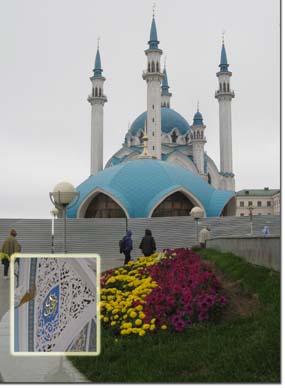 Kazan very pretty, feels more like Turkey than Russia.
It is a mix of Orthodox and Muslim
religions, and the kremlin contains churches to both religions.
There is also a great deal of higher education in the city, although
this particular building, the aeronautical institute, looked pretty beat
up. But these apparently were the folks that brought us the Kamen
helicopter
Kazan very pretty, feels more like Turkey than Russia.
It is a mix of Orthodox and Muslim
religions, and the kremlin contains churches to both religions.
There is also a great deal of higher education in the city, although
this particular building, the aeronautical institute, looked pretty beat
up. But these apparently were the folks that brought us the Kamen
helicopter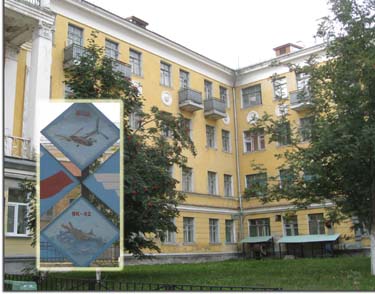 line.
line.
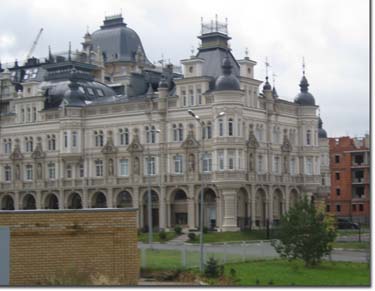
After overlooking some
very rich living enclaves, complete with yacht slips and helicopter pads
- yes Virginia, there is money in Russia - it just is concentrated at a
very narrow end. We took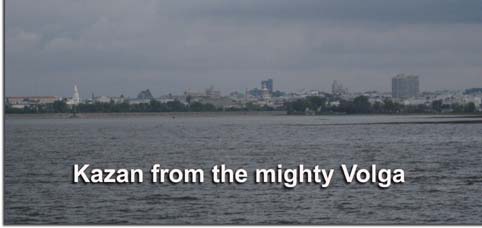 as short boat trip on the Volga. And other than it being a "short
boat trip on the Volga" there wasn't very much to it.
as short boat trip on the Volga. And other than it being a "short
boat trip on the Volga" there wasn't very much to it.
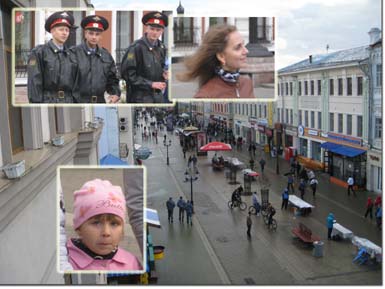 The
day concluded with lunch in a local restaurant, a music show featuring
music from Feodor Chaliapin (which I
sort of slept through - sorry) and then free time for shopping and Wi-Fi
access at a local hotel.
There was a major police presence in this market area. And always
the cops were in groups of three. Hum.
The
day concluded with lunch in a local restaurant, a music show featuring
music from Feodor Chaliapin (which I
sort of slept through - sorry) and then free time for shopping and Wi-Fi
access at a local hotel.
There was a major police presence in this market area. And always
the cops were in groups of three. Hum.
How did these guys do it – army and technology but nothing for infrastructure and people. The day ended as we reboarded the train, and we are now hurtling toward Moscow, and the end of the journey.
Sept 19
This is the last night on the train.
Some rocking and rolling but no one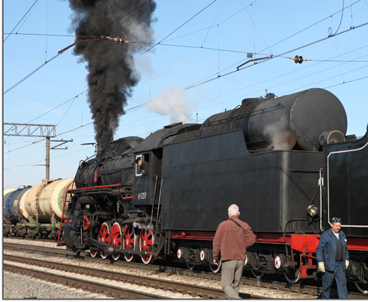 knows how difficult it will
be to try to sleep without it.
Today we have steam! The whole line was pulled by steam back when
it opened to the west in 1992. But now it is just too expensive to
run for that distance, and we only have it for show on the last 100 km
into/out of Moscow. And note that we are doubled headed.
These photos are from Kent, as
I forgot to put the blasted media card
back in the camera. These engines are more of the 2-10-2 type that
we have been seeing. Like I said, the Russians
knows how difficult it will
be to try to sleep without it.
Today we have steam! The whole line was pulled by steam back when
it opened to the west in 1992. But now it is just too expensive to
run for that distance, and we only have it for show on the last 100 km
into/out of Moscow. And note that we are doubled headed.
These photos are from Kent, as
I forgot to put the blasted media card
back in the camera. These engines are more of the 2-10-2 type that
we have been seeing. Like I said, the Russians
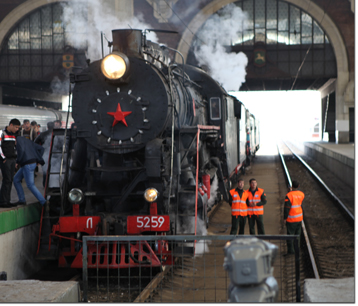 must
have made a bunch of them.
must
have made a bunch of them.
Our arrival in Moscow station made quite a stir. There we so many people taking cell phone photos.
So here we are back in the most expensive city on the planet –
Moscow.
There is no doubt
about the amount of money available seeing the number of Benz S600 and high end BMWs and Audis
around.
Off to Moscow
University for the usual stop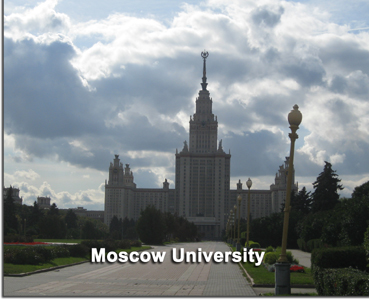 with the street vendors and to overlook the
city. I
had read a long time ago that Iowa State University's main dorm
building - Friley Hall, was second in size only to Moscow U. I
don't know if it is true, but here we can at least see the primary
institution.
with the street vendors and to overlook the
city. I
had read a long time ago that Iowa State University's main dorm
building - Friley Hall, was second in size only to Moscow U. I
don't know if it is true, but here we can at least see the primary
institution.
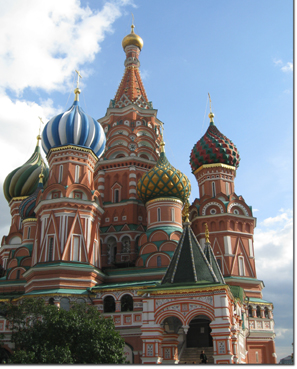 Then
we moved on to St. Basils and
Red Square.
I'm still struck by how relatively small Red
Square is. After seeing all those parades and waving Russian
dignitaries (with subsequent airbrushed photos) as a kid, I really
thought it would be - huge.
Then
we moved on to St. Basils and
Red Square.
I'm still struck by how relatively small Red
Square is. After seeing all those parades and waving Russian
dignitaries (with subsequent airbrushed photos) as a kid, I really
thought it would be - huge.
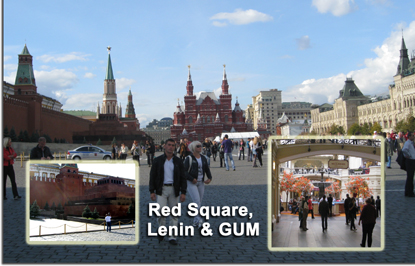
We did a quick walk though of GUM department store, which is now mostly high end shops. It was still clean and beautiful, but a shopping mall none the less.
How many tanks can you fit in this place? Not as many as I would have thought. But you can inter a bunch of dead past dictators in the walls. Once again, Lenin's Tomb was closed, so I guess I will have missed my chance to see him.
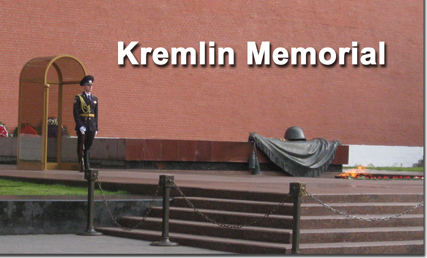 I
did manage to get a photo of yet another war memorial, before being
shooed away. I don't quite understand the ban on photos.
I
did manage to get a photo of yet another war memorial, before being
shooed away. I don't quite understand the ban on photos.
If I had one complaint on this trip, it was
this afternoon. Our guide did
not stop talking for four solid hours.
John had not seen the Armory, so I went and got the camera out of
checked luggage, as we couldn’t take it into the buildings.
The Russians determine things by lens size, which is a smart
move.
We are in the
Marriott, and as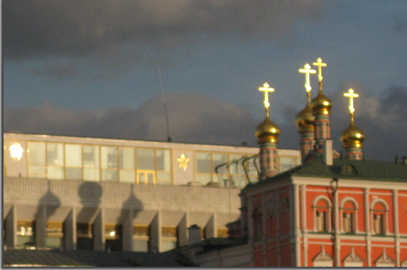 usual, the shorter the stay, the better the room.
There is lots of room here.
This has been an amazing trip – really the trip of a lifetime.
I never thought that I would get to take the Trans Siberian
Railway, and see the immensity of Russia.
usual, the shorter the stay, the better the room.
There is lots of room here.
This has been an amazing trip – really the trip of a lifetime.
I never thought that I would get to take the Trans Siberian
Railway, and see the immensity of Russia.
Sept 20
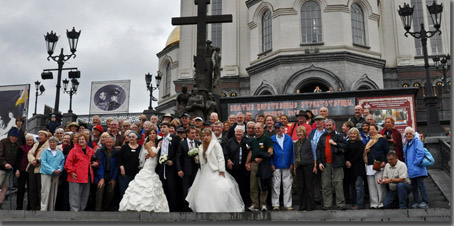 We
said good-bye to our fellow travelers today. Some were continuing
on to St. Petersburg via river cruise, while some left for home.
Note that the brides just sort of showed up in the photo!
We
said good-bye to our fellow travelers today. Some were continuing
on to St. Petersburg via river cruise, while some left for home.
Note that the brides just sort of showed up in the photo!
Off for the airport early this morning. We were delivered to Sheremetyevo in good time, and had access to the first class lounge. The flight to Warsaw was lovely and the Aeroflot flight attendants in their 1950’s style peaked hats and nifty red uniforms (with heels, no less) were quite a sight. I guess the economy section did not have such amenities. No photos, so you’ll have to use your imagination. We killed about 5 hours in Warsaw, the picked up LOT for the 10+ hour return to Chicago. This flight was jammed, and while business class was OK, economy was the pits.
We were all be glad to
get home.
Most of us have colds, and
are really tired.
This was
the trip of a lifetime.
I
have always found Russia to be a fascinating country.
There is such a dichotomy of highs and lows, of extremes.
From the stoicism of the country towns, the flash of the big
cities, from the modern structures to the crumbling factories.
Russia is, as Winston Churchill said, “A riddle, wrapped in a
mystery inside an enigma.”
And there is no better way to see it – at least as a short term tourist
– than by rail.
And the
Golden Eagle does an exemplary job of showing you – Russia.
The short version (length 8:47)